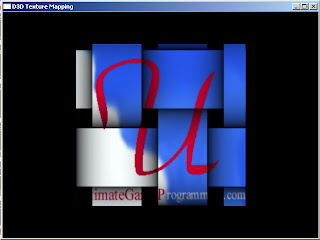
In this chapter we learned how direct x manages textures. We also learned how the code can make images into textures like you can see on the right side. This is the first time I have heard of Direct x being able to do that. The code for the process is below with comments.
/*
Demo Name: Texture Mapping
Author: Allen Sherrod
Chapter: Ch 4
*/
#include
#include
#define WINDOW_CLASS "UGPDX"
#define WINDOW_NAME "D3D Texture Mapping"
#define WINDOW_WIDTH 640
#define WINDOW_HEIGHT 480
// Function Prototypes...
bool InitializeD3D(HWND hWnd, bool fullscreen);
bool InitializeObjects();
void RenderScene();
void Shutdown();
// Direct3D object and device.
LPDIRECT3D9 g_D3D = NULL;
LPDIRECT3DDEVICE9 g_D3DDevice = NULL;
// Matrices.
D3DXMATRIX g_projection;
D3DXMATRIX g_ViewMatrix;
// Vertex buffer to hold the geometry.
LPDIRECT3DVERTEXBUFFER9 g_VertexBuffer = NULL;
// Holds a texture image.
LPDIRECT3DTEXTURE9 g_Texture = NULL;
// A structure for our custom vertex type
struct stD3DVertex
{
float x, y, z;
unsigned long color;
float tu, tv;
};
// Our custom FVF, which describes our custom vertex structure
#define D3DFVF_VERTEX (D3DFVF_XYZ D3DFVF_DIFFUSE D3DFVF_TEX1)
LRESULT WINAPI MsgProc(HWND hWnd, UINT msg, WPARAM wParam, LPARAM lParam)
{
switch(msg)
{
case WM_DESTROY:
PostQuitMessage(0);
return 0;
break;
case WM_KEYUP:
if(wParam == VK_ESCAPE) PostQuitMessage(0);
break;
}
return DefWindowProc(hWnd, msg, wParam, lParam);
}
int WINAPI WinMain(HINSTANCE hInst, HINSTANCE prevhInst, LPSTR cmdLine, int show)
{
// Register the window class
WNDCLASSEX wc = { sizeof(WNDCLASSEX), CS_CLASSDC, MsgProc, 0L, 0L,
GetModuleHandle(NULL), NULL, NULL, NULL, NULL,
WINDOW_CLASS, NULL };
RegisterClassEx(&wc);
// Create the application's window
HWND hWnd = CreateWindow(WINDOW_CLASS, WINDOW_NAME, WS_OVERLAPPEDWINDOW,
100, 100, WINDOW_WIDTH, WINDOW_HEIGHT,
GetDesktopWindow(), NULL, wc.hInstance, NULL);
// Initialize Direct3D
if(InitializeD3D(hWnd, false))
{
// Show the window
ShowWindow(hWnd, SW_SHOWDEFAULT);
UpdateWindow(hWnd);
// Enter the message loop
MSG msg;
ZeroMemory(&msg, sizeof(msg));
while(msg.message != WM_QUIT)
{
if(PeekMessage(&msg, NULL, 0U, 0U, PM_REMOVE))
{
TranslateMessage(&msg);
DispatchMessage(&msg);
}
else
RenderScene();
}
}
// Release any and all resources.
Shutdown();
// Unregister our window.
UnregisterClass(WINDOW_CLASS, wc.hInstance);
return 0;
}
bool InitializeD3D(HWND hWnd, bool fullscreen)
{
D3DDISPLAYMODE displayMode;
// Create the D3D object.
g_D3D = Direct3DCreate9(D3D_SDK_VERSION);
if(g_D3D == NULL) return false;
// Get the desktop display mode.
if(FAILED(g_D3D->GetAdapterDisplayMode(D3DADAPTER_DEFAULT, &displayMode)))
return false;
// Set up the structure used to create the D3DDevice
D3DPRESENT_PARAMETERS d3dpp;
ZeroMemory(&d3dpp, sizeof(d3dpp));
if(fullscreen)
{
d3dpp.Windowed = FALSE;
d3dpp.BackBufferWidth = WINDOW_WIDTH;
d3dpp.BackBufferHeight = WINDOW_HEIGHT;
}
else
d3dpp.Windowed = TRUE;
d3dpp.SwapEffect = D3DSWAPEFFECT_DISCARD;
d3dpp.BackBufferFormat = displayMode.Format;
// Create the D3DDevice
if(FAILED(g_D3D->CreateDevice(D3DADAPTER_DEFAULT, D3DDEVTYPE_HAL, hWnd,
D3DCREATE_SOFTWARE_VERTEXPROCESSING, &d3dpp, &g_D3DDevice)))
{
return false;
}
// Initialize any objects we will be displaying.
if(!InitializeObjects()) return false;
return true;
}
bool InitializeObjects()
{
// Fill in our structure to draw an object.
// x, y, z, color, texture coords.
stD3DVertex objData[] =
{
{-0.3f, -0.4f, 0, D3DCOLOR_XRGB(255,255,255), 0, 1},
{0.3f, -0.4f, 0, D3DCOLOR_XRGB(255,255,255), 1, 1},
{0.3f, 0.4f, 0, D3DCOLOR_XRGB(255,255,255), 1, 0},
{0.3f, 0.4f, 0, D3DCOLOR_XRGB(255,255,255), 1, 0},
{-0.3f, 0.4f, 0, D3DCOLOR_XRGB(255,255,255), 0, 0},
{-0.3f, -0.4f, 0, D3DCOLOR_XRGB(255,255,255), 0, 1}
};
// Create the vertex buffer.
if(FAILED(g_D3DDevice->CreateVertexBuffer(sizeof(objData), 0,
D3DFVF_VERTEX, D3DPOOL_DEFAULT,
&g_VertexBuffer, NULL))) return false;
// Fill the vertex buffer.
void *ptr;
if(FAILED(g_VertexBuffer->Lock(0, sizeof(objData),
(void**)&ptr, 0))) return false;
memcpy(ptr, objData, sizeof(objData));
g_VertexBuffer->Unlock();
// Load the texture image from file.
if(D3DXCreateTextureFromFile(g_D3DDevice, "ugp.tga",
&g_Texture) != D3D_OK) return false;
// Set the image states to get a good quality image.
g_D3DDevice->SetSamplerState(0, D3DSAMP_MINFILTER,
D3DTEXF_LINEAR);
g_D3DDevice->SetSamplerState(0, D3DSAMP_MAGFILTER,
D3DTEXF_LINEAR);
// Set default rendering states.
g_D3DDevice->SetRenderState(D3DRS_LIGHTING, FALSE);
g_D3DDevice->SetRenderState(D3DRS_CULLMODE, D3DCULL_NONE);
// Set the projection matrix.
D3DXMatrixPerspectiveFovLH(&g_projection, 45.0f,
WINDOW_WIDTH/WINDOW_HEIGHT, 0.1f, 1000.0f);
g_D3DDevice->SetTransform(D3DTS_PROJECTION, &g_projection);
// Define camera information.
D3DXVECTOR3 cameraPos(0.0f, 0.0f, -1.0f);
D3DXVECTOR3 lookAtPos(0.0f, 0.0f, 0.0f);
D3DXVECTOR3 upDir(0.0f, 1.0f, 0.0f);
// Build view matrix.
D3DXMatrixLookAtLH(&g_ViewMatrix, &cameraPos,
&lookAtPos, &upDir);
return true;
}
void RenderScene()
{
// Clear the backbuffer.
g_D3DDevice->Clear(0, NULL, D3DCLEAR_TARGET,
D3DCOLOR_XRGB(0,0,0), 1.0f, 0);
// Begin the scene. Start rendering.
g_D3DDevice->BeginScene();
// Apply the view (camera).
g_D3DDevice->SetTransform(D3DTS_VIEW, &g_ViewMatrix);
// Draw square.
g_D3DDevice->SetTexture(0, g_Texture);
g_D3DDevice->SetStreamSource(0, g_VertexBuffer,
0, sizeof(stD3DVertex));
g_D3DDevice->SetFVF(D3DFVF_VERTEX);
g_D3DDevice->DrawPrimitive(D3DPT_TRIANGLELIST, 0, 2);
// End the scene. Stop rendering.
g_D3DDevice->EndScene();
// Display the scene.
g_D3DDevice->Present(NULL, NULL, NULL, NULL);
}
void Shutdown()
{
if(g_D3DDevice != NULL) g_D3DDevice->Release();
g_D3DDevice = NULL;
if(g_D3D != NULL) g_D3D->Release();
g_D3D = NULL;
if(g_VertexBuffer != NULL) g_VertexBuffer->Release();
g_VertexBuffer = NULL;
if(g_Texture != NULL) g_Texture->Release();
g_Texture = NULL;
}
No comments:
Post a Comment